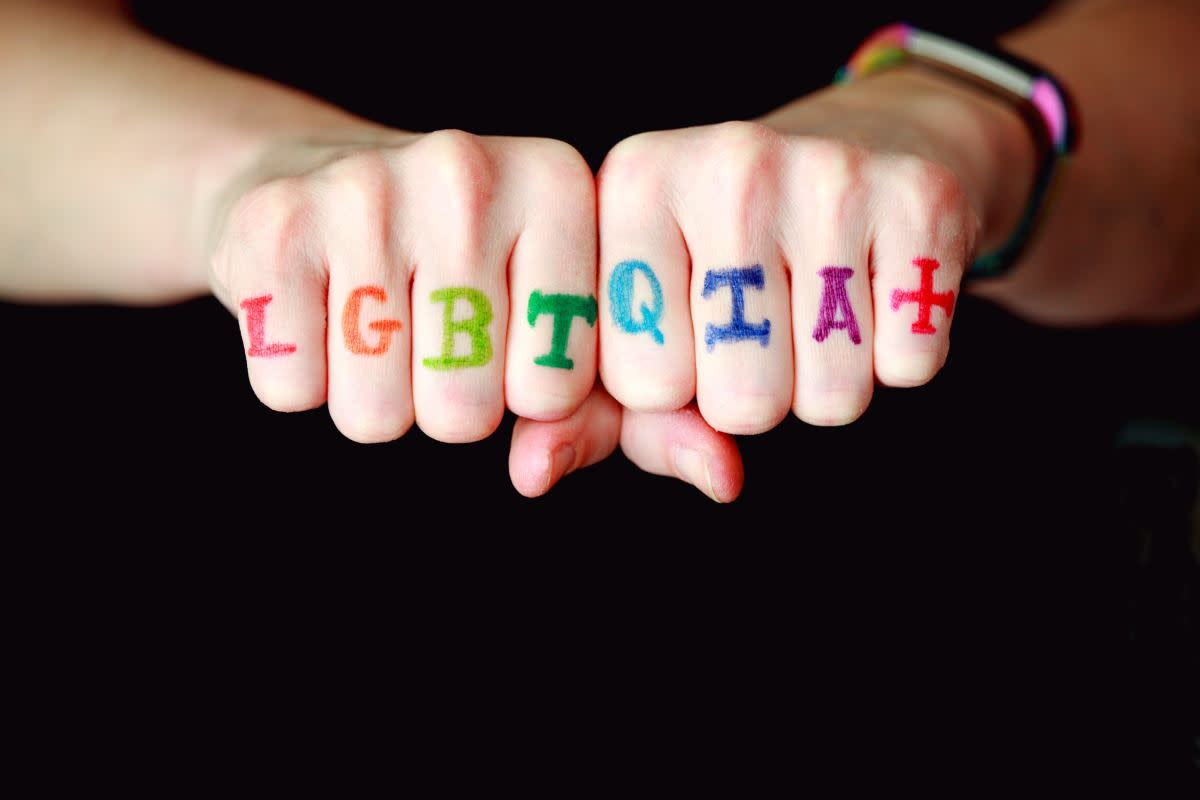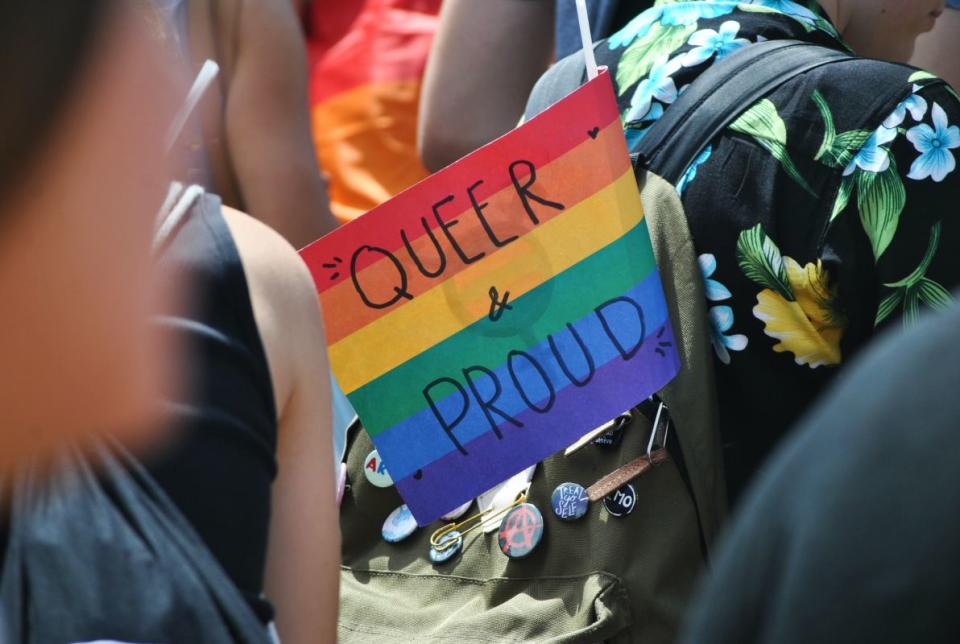What Does LGBTQ+ Stand For? Every Letter Is Important

While Pride Month is a great time to celebrate the queer community, it’s also a great time to learn about LGBTQ+ history. And in doing so, it’s probably a good idea to get familiar with what LGBTQ+ means in the first place.
As with everything throughout history, there is a rich progression when it comes to terms used for the LGBTQ+ community. Right now, it’s pretty inclusive, but that wasn’t always the case. Just like the greater society at large has to learn and accept all gay people, the queer community has also had to grow to include every facet of our queer population. With that said, here’s the history of the acronym LGBTQ+ and what LGBTQ+ stands for.
Related: What Date Is Pride 2024? When Is Your City's Pride Parade?
What is the history of LGBTQ+?
According to National Geographic, the longer acronym, “LGBTQ+,” that we know today started out smaller and has evolved with the growing community. In the 1990s, the acronym LGB (lesbian, gay, bisexual) came into popularity because of “the longstanding bonds” between those three groups within the community. But of course, more members needed representation.
All terms and labels that make up LGBTQ+ came about at different times, giving way to the interesting evolution of the term for the queer population. Even the reclamation of the word “queer” had an impact. Throughout history, the community has been called different things—gay, LGB, etc.—and today the acronym of LGBTQ+ is the most inclusive it’s been.
What does each letter in LGBTQ+ mean?
Below, we go into what each letter of LGBTQ+ means, but we'll give you a quick rundown. LGBTQ+ is an acronym that is a way to reference the entire community in an inclusive way without having to name every identity that exists within the queer population.
LGBTQ+ stands for lesbian, gay, bisexual, transgender, queer (and more). Now, let's get into the specifics.
L: Lesbian
As National Geographic reported, the term “lesbianism” or “lesbian” is the oldest label out of the LGBTQ+ acronym. This is because of the Greek poet, Sappho, and her “sapphic” poetry. She was from the island of Lesbos, so that’s where “lesbianism” gets its name.
The word “lesbian” has obviously evolved in its usage. Still, the modern use of the term started in the 1890s and continued to be the go-to label for queer women who dated other women (even if they were bisexual since that label wasn't used in its modern way yet. More on that later). Now, “lesbian” is the label women or non-men use if they are attracted to other women and non-men. Lesbianism does not exclude transgender women or non-binary individuals, even if a louder minority claims it does.
Related: What Does the Lesbian Flag Look Like? Here's Why You Might See So Many Variations of the Lesbian Flag
G: Gay
The term “homosexual” came right before the modern use of the term “lesbian.” Austro-Hungarian journalist Karoly Maria Kertbeny coined the term in 1869 along with “heterosexual.” “Gay” (as in sexuality, not as in “happy”) came around later, and for decades, it was used as a slur. Unfortunately, that’s still the case in some instances today—Hilary Duff would like to squash that practice, as we thank her for her work—but by the 1960s, queer people started to reclaim the word.
Of course, gay did and still does refer to men who are attracted to other men. By the 1970s, gay was used as a sort of umbrella term for all members of the community, especially during the Gay Rights movement. And because of this, “gay” was also used to describe the community.
B: Bisexual
Kertbeny, who coined “homosexual” and “heterosexual” also introduced the label “bisexual” into the greater conversation. However, in 1859, the term “bisexuality” was thought to refer to a person with both male and female physical characteristics (which is what we would now call intersex—more on that later).
Once we got to modern-day usages of “lesbian” and “gay,” a lot of people just used those terms while also acknowledging that they liked more than one gender. But bisexuality, as we know it today, took off during the Gay Rights movement, with bi groups popping up by the 1980s. And as the 1990 Bisexual Manifesto—which appeared in bisexual lit and art magazine Anything That Moves—stated, bisexuality wasn’t binary and was fluid. So since its origin, bisexuality has never been about “two” genders and hasn’t been trans-exclusionary (which is, unfortunately, a common misconception).
Related: What Does Bisexual Mean?
T: Transgender
In the beginning, there have been a lot of terms and names for transgender individuals that are outdated or offensive today. The label “transgender” wasn’t really used until 1965, according to National Geographic. Activists like Virginia Prince championed the use of “transgender” since sexuality and gender are two separate things. Transgender people's gender identity is different than the one they were assigned at birth. They can take medicine or have surgeries that help them transition, physically, to their correct gender. But transgender people don't have to physically transition either. Some also use the term non-binary, but not all non-binary people identify as trans.
By the ‘90s, transgender people within the gay community wanted to be seen and respected (especially since the acronym LGB was being used, excluding other queer people). So, by the late ‘90s, the T was added to LGBT and "transgender" was more widely accepted by the 2000s. However, there is still a lot of misunderstanding and hate toward transgender people today.
Related: 50 LGBTQ+ Quotes for Pride Month and Coming Out
Q: Queer

Delia Giandeini/Unsplash
Maybe you’ve been reading this piece and have been thinking about the use of the term “queer.” It’s a slur, right? Well, yes, if spoken by non-queer people in a derogatory manner (don’t let Hilary Duff catch you saying this one like that either!).
But the word has been reclaimed by the community and, as a label, is growing in popularity. Some people in the LGBTQ+ community use it in conjunction with their other labels and identities, and others use only the label “queer.” The "Q" was added to the acronym as the community grew to be more inclusive of all, and since queer is such a big umbrella term, it covers a lot of identities.
Q: Questioning
Even though our common gay acronym is LGBTQ+, with just one “Q,” there’s another label that the letter stands for as well. A lot of people recognize that the Q also stands for "questioning," which stands for people who aren’t sure where they fit in within the gay community or don’t have a name for how they identify yet.
Pride Month—and respect within the queer community—isn’t contingent on how you identify, who you’ve slept with (or not slept with) or if you’re out. It’s all about personal discovery and defining who you are for yourself, so people who aren't sure what label they want to use are, of course, still a part of the community.
+: Plus
To make things read easier and flow better—along with the fact that it is the common, most well-known acronym for the gay population—we at Parade just use LGBTQ+. This is the same with a lot of other organizations and sites. And that “+” is really important because it leaves the term open-ended to include as many identities as exist in the community. This includes people who are non-binary, gender non-conforming, genderqueer and so much more.
For example, there is one acronym, LGBTQQIP2SAA, which includes intersex, pansexual, two-spirit, asexual and ally. That isn’t an acronym that most people know nor can decipher easily (and includes allies which is highly contested and usually not accepted as part of the LGBTQ+ acronym and definitely not a part of the gay community). A more common acronym is LGBTQIA+, which includes two identities we’ll talk about next. Again, the plus in LGBTQ+ has a big job and makes it one of the most inclusive acronyms for the queer population.
Related: The 30+ Best Items From Target's Pride Collection
I: Intersex
Intersex isn’t as common a label as the others, but it’s still a label that people have used for a while. As the Gay Center defines it, intersex describes someone who has one or more “innate sex characteristics,” whether that be with reproductive organs, genitals or chromosomes. This would make them “outside of traditional concepts” of the physical gender binary that we know today. This is different than transgender because intersex people are assigned a gender at birth despite not fitting quite into that criteria, physically, and doctors and parents make this decision even if it’s not accurate to what the child actually is.
The “I” was added in the 2010s, and is still used in the longer version of LGBTQ+, which is LGBTQIA+.
A: Asexual
Asexual people are those that experience no sexual attraction to any gender. This can be shortened to “ace” and is different (but similar) to aromantic, which is a label for people who don’t have emotional or romantic attractions but might not experience asexuality. The "A" stands for not just asexual, but also any sexuality under the "ace umbrella," which also includes aromantic, agender, demisexual and more. The term "asexual" started popping up more in the 2010s, and the "A" was added to the larger LGBTQIA+ acronym by 2015, per The Daily Beacon.
Next up, learn what the word "sapphic" means and how it relates to "wlw."
